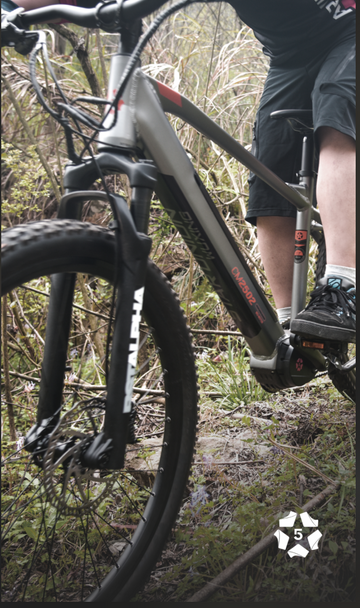
With the continuous evolution of mountain bikes and road bikes, hydraulic disc brakes have become a standard feature due to their superior braking performance and stability. However, for beginners, hydraulic disc brakes may seem complex and challenging to use. In this guide, we will walk you through the correct way to use hydraulic disc brakes and provide useful maintenance and care tips to make your riding experience safer and more enjoyable.
What Are Hydraulic Disc Brakes?
Hydraulic disc brakes are a type of brake system that uses hydraulic fluid to transmit braking force, as opposed to mechanical disc brakes that rely on cables. This hydraulic system offers superior braking power and smoother control. The main benefits of hydraulic disc brakes include:
· Higher Braking Power: Even in wet or muddy conditions, hydraulic disc brakes provide consistent and strong braking performance.
· Smoother Braking Experience: Hydraulic systems evenly distribute braking force, preventing the jerky or uneven braking that can occur with mechanical systems.
· Lower Maintenance Needs: Compared to mechanical brakes, hydraulic disc brakes require less frequent adjustments and are generally more durable.

How to Properly Use Hydraulic Disc Brakes
Although hydraulic disc brakes offer excellent performance, improper use can lead to unnecessary wear or unsafe riding conditions. Here are some tips to help you use hydraulic disc brakes correctly:
1.Proper Braking Technique
When riding, avoid slamming on the brakes, especially at high speeds. Sudden, forceful braking can cause loss of control and increase brake wear. Instead, practice a gradual braking technique where you steadily increase braking force until you slow down or come to a stop.
2.Don’t Squeeze the Brake Levers Too Hard
Hydraulic disc brakes are highly sensitive. To prevent unnecessary wear, avoid pulling the brake levers too tightly. Applying moderate pressure ensures that the brake pads and discs don’t wear out prematurely and prolongs the lifespan of your braking system.
3.Keep Brake Discs and Pads Clean
The performance of your hydraulic disc brakes heavily depends on the contact between the brake pads and brake discs. Regularly clean the brake discs, especially after riding in muddy or wet conditions, to maintain optimal braking performance. Use a dedicated brake disc cleaner or a damp cloth to wipe the disc surface, and avoid using oil-based or corrosive substances.

4.Avoid Contact with Oil-Based Lubricants
Brake pads and discs are highly sensitive to contamination by oils or lubricants. Exposure to oil or grease will significantly reduce braking efficiency. Be mindful when applying lubricants to other parts of the bike and avoid letting any contact with the brake system.
How to Maintain Hydraulic Disc Brakes
Regular maintenance not only improves the braking performance of hydraulic disc brakes but also extends their lifespan. Here are some tips to keep your hydraulic disc brakes in top condition:
1.Check Brake Fluid Levels
Regularly check the brake fluid levels to ensure that they are adequate. Low fluid levels can lead to unstable braking performance and may even cause brake failure. If you notice the fluid level is low, top it up with the appropriate hydraulic fluid for your system.
2.Replace Worn Brake Pads
When the brake pads become too worn, they should be replaced immediately. Most brake pads have a wear indicator, which helps you monitor their condition. If the pads are worn too thin, braking efficiency will decrease, and you may damage the brake discs.
3.Inspect Brake Discs for Wear
Brake discs also wear out over time. Regularly inspect your discs for signs of wear, including cracks, warping, or excessive thinning. If you notice significant wear or damage, replace the discs to maintain optimal braking performance.

4.Check Brake Fluid Quality
Over time, hydraulic brake fluid can degrade due to moisture or contamination. It is recommended to check the fluid quality at least once a year and replace it if necessary. Using the wrong type of hydraulic fluid can lead to brake failure or permanent damage to the brake system.
Common Issues and Solutions
1.Brakes Feel Weak or Unresponsive
This could be due to low brake fluid or contaminated fluid. Check the fluid level and replace or top it up if necessary. If the problem persists, inspect the brake pads for excessive wear or check for debris on the brake discs.

2.Brake Lever Feels Soft
A soft brake lever could indicate air in the hydraulic system. If this happens, you will need to bleed the brake system to remove the trapped air. This process will restore the proper brake feel and function.

3. Noise in the brake system
Rattles are usually caused by foreign objects (e.g. sand, dirt) on the brake pads or discs. Clean the brake discs and pads to solve the problem.

Conclusion
Hydraulic disc brakes are a powerful braking technology that can enhance your riding experience, but using them properly and maintaining them regularly is key to ensuring safety and optimal performance. Whether you're a beginner or an experienced rider, understanding how to use and care for hydraulic disc brakes is essential.
We hope this guide helps you get the most out of your hydraulic disc brakes and enjoy a safer, more comfortable ride.
If you're looking for high-quality hydraulic disc brake components or need professional maintenance services, visit our Shopify Store for a wide selection of products and expert support. We’ve got everything you need to keep your bike in top condition!




